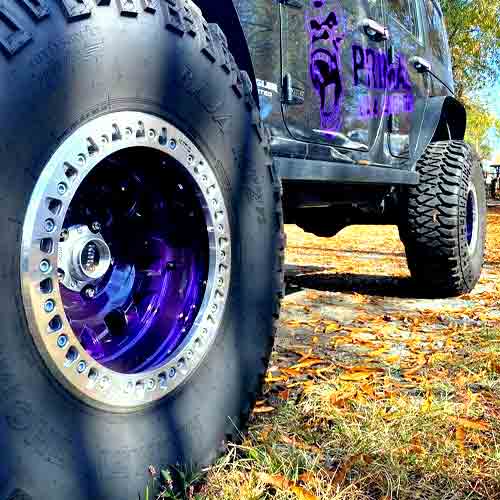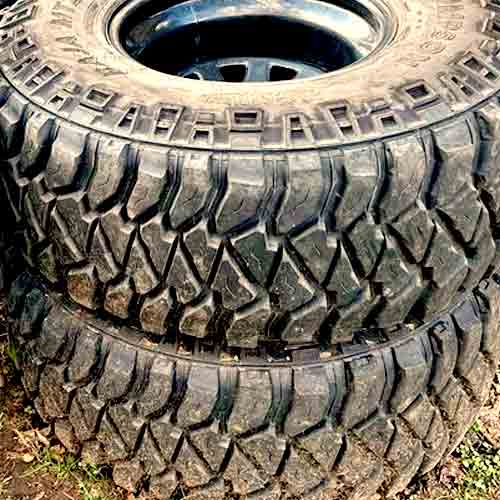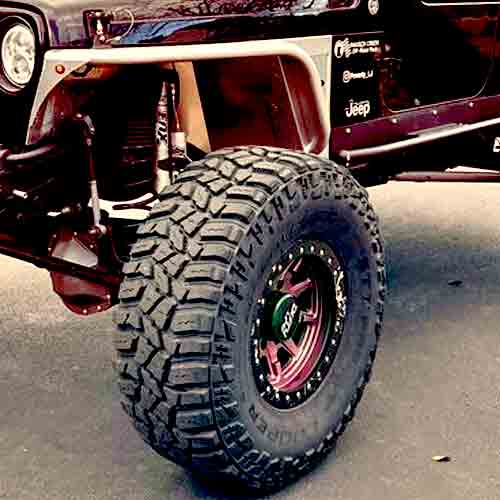The Mickey Thompson Baja MTZ, a rugged terrain specialist, and the Cooper Discoverer STT Pro, designed for mud terrain, both excel in all kinds of environments. Let’s delve into their features to determine which tire suits your needs the best!

Table of Contents
Must-Know Facts
The Cooper Discoverer STT Pro offers 49 total sizes in 15″ to 22″ rim sizes, coming with following specs.
- All have speed rating of Q.
- Load Ratings: C to F.
- Weight Range: 42 lbs to 94 lbs.
- Tread Depth Range: 18 to 22/32″, where most of the sizes get to have 21/32″.
On the other side, the Mickey Thompson Baja MTZ offers you with 15 to 20 inches rims, with following specs:
- Speed ratings: Q only.
- Load range: C to F.
- Weight range: 47 to 94 lbs.
- Tread depth range: 19.5 to 22/32″.
Tread Structure
Both tires feature a very unique tread design. Let me start off with Baja MTZ first.

There are 2 ribs seen in the middle on its tread, and they contain sharp triangular blocks with yet sharper chamfered edges, combined with off-set sides and V shaped sipes.
And although they make prominent outer longitudinal channels, they are more aligned laterally, connecting one shoulder block on the symmetric tread to the other, allowing for sideways evacuation of mud and dirt particles off-road.
And at the same time, with closeness, they also get to provide ample footprint contact with the road on smooth surfaces, providing stability.
Though the very same can’t be said about lateral traction as that depends on shoulder lugs, and they have huge tread voids.
Though off-road they are epic, as they feature similar (to the middle) biters, staggered outer edges and sidewall lugs.
But they are still no match for the Cooper Discoverer STT Pro.

This tire features a more voided up tread, where you see more prominent mixture of longitudinal and sideways grooves.
The central lugs, consisting of various shapes and sizes, feature very biting off-set edges, and sharp sides, mainly for off-road use.
While for on-road stability they have reinforced foundations underneath, which allow them to have a very good steering response, comparing other mud terrain variants, I mean.
Moreover, these lugs also feature interlocking sipes, which really aid in wet surfaces.
Though the highlight of the tire’s tread is its shoulders.
These staggered shoulder lugs are elongated in a way, that they look like they are trying to join up with the lugs on the other side (through the help of those in the middle). They although carry all the features, seen in the middle, they also have snow vices, and thick longitudinal in-groove notches to them.
Moreover, needless to say, they join up to very thick sidewall lugs, as seen in the image.
Durability
Durability is a crucial factor for off-road tires that face rough terrain and sharp objects, and so you need robust internal and outer construction.
That’s why both of these tires offer 3 ply polyester casings with 2 steel belts and a single nylon reinforcement.
Also both of these tires have PowerPly XD sidewalls construction, where the third fold of the polyester casing is thicker. This makes sidewalls very resistant to all kinds of punctures.
Wet Traction
A tire’s optimal performance on wet surfaces is derived from the combined effect of siping and tread flexibility.
Sipes, essentially, absorb water in their slits, creating suction (by contracting and expanding). That’s why you also need flexibility of the tread for them.
Now although the Cooper STT Pro is a great tire comparing other mud terrain options out there, it still lacks to its counterpart here (by a tiny margin, I should add).
The Mickey Thompson MTZ offers superior clearing of water with the help of its sipes, though the overall float speeds for both tires is seen similar (on tests), in both straight and curved aqua planes.
For folks who don’t know, float speeds measure hydroplaning resistance.
Dry Highways
Aggressive off-road tires, like our boys here, aren’t traditionally acclaimed for their highway performance, but their robust abilities allow some concessions on steering response as well as lateral/directional traction—these being the key elements of dry performance.
Let’s dissect these components individually.
Directional Grip
The necessity for directional traction primarily arises during braking and acceleration, hence it’s measured using stopping distances.
Let me explain what’s happening here.
As a tire rolls straight, most of its weight concentrates on the central tread area. Therefore, the amount of footprint a tire can create from this area becomes crucial.
This is why, among the two, the Mickey Baja MTZ showcases superior traction with its densely packed central area.
Its lugs not only closely group together but also form an interlocking pattern, fostering an evenly distributed weight as the tire moves.
In contrast, the Cooper STT Pro yields two feet shorter braking distances on average. This is logical, given its wider tread voids and lateral orientation of lugs.
Handling and Steering Response
Handling is largely contingent on a tire’s structural weight and the extent of contact its shoulder lugs can maintain.
And despite both tires offering a very voided up structure, the Mickey Thompson Legend MTZ exhibits more effective handling due to its superior steering response.
Steering response serves as a crucial measure of a tire’s communicative capacity. In this aspect, the Legend MTZ outshines, demonstrating higher sensitivity to steering inputs.
On the flip side, the Cooper STT Pro lacks with its softer compound and larger tread depth. Both of these features, although really help off road, they cause lug bending, which in return compromises on steering feedback.
Fuel Usage
Fuel consumption is in direct correlation with rolling resistance, which is significantly influenced by the tread’s bending susceptibility.
That’s why it can be explained why with similar weight range, the Mickey Baja MTZ still manages to yield lower values for rolling resistance.
Basically the tire’s lugs, especially in the center, are more densely packed, facilitating a more even weight distribution and exerting less pressure on each lug as they interact with the road.
And this results in lower susceptibility to blocks’ bending.
On the contrary, the Cooper Discoverer STT Pro applies more pressure on its lugs, and that combined with its softer overall tread compound, its lugs get to mold a lot more against the road, resulting in increased energy loss.
Ride Comfort
The ride quality of a tire depends on the tread noise it generates and its ability to mitigate bumps on and off the road.
Now, both of these tires are not quiet by any means. So let’s get that out of the way.
But comparing both, you would see a tiny bit of a better result on Mickey Thompson Baja MTZ, where the tire’s tread design is less susceptible to groove resonance and employs better variable pitch technology.
On the other side, with relatively softer compound, the STT Pro offers a more pliable tread, which is superior at soaking up the vibrations of the road.
Off Road Performance
In off-road environments, I tested these tires on several terrains, including rocky, and sandy areas as well as muddy grounds.
Find them all below.
Sandy Areas
On sand, a tire that digs less excels, hence both weight and tread structure become significant factors. As such, it’s understandable why the Cooper STT Pro, with its lighter structure and larger surface area of sidewall lugs, provides better traction.
Since both tires offer similar weights across their sizes, the STT Pro still have the upper hand, thanks to its killer sidewall lugs which flex and spread out very nicely with lowered air pressure.
On the other hand, the Baja MTZ’s stiffer sides don’t perform so well, as they increase the tire’s susceptibility to sink in this soft terrain type.
Muddy Terrains
In muddy conditions, self-cleaning grooves are essential. That’s because, if mud clogs the tread, traction with the muddy surface is lost. (As mud slips on mud).
Now it should be obvious one, that the Cooper STT Pro slightly outperforms the Mickey Thompson Baja MTZ.
The STT Pro tire’s numerous pathways across the tread facilitate the expulsion of mud from the tread more efficiently, while its elongated shoulders and laterally oriented lug design contribute to superior mud scooping.
The Mickey Thompson Baja MTZ, although effective in mud evacuation as well, still falls a bit short in the paddling aspect.
Meaning, it doesn’t have laterally oriented lugs like its competitor, which effectively throw mud backwards to generate forward moving inertia.
Rocks
On rocks, you need a grip in all directions, along with durability. And in both aspects, the mud-terrain variant is taking the lead.
The Cooper STT Pro edges out its competitor with superior angled-gripping.
Its numerous biting edges , oriented laterally and longitudinally, enhance grip in all directions as they split up the blocks and simultaneously function as big in-groove notches.
The Legend EXP on the other hand, is missing with these features. This tire does not offer big enough groove mouth as its counterpart, and its lugs are missing with as many of the biters too.
To Sum Up
In summing up, both the Mickey Thompson Baja MTZ and Cooper Discoverer STT Pro show exceptional performance across various terrains, each with distinct strengths.
The MTZ excels in steering response, fuel efficiency, and wet traction, while the STT Pro shines on muddy, rocky terrains and sandy areas.
So what will be your pick?